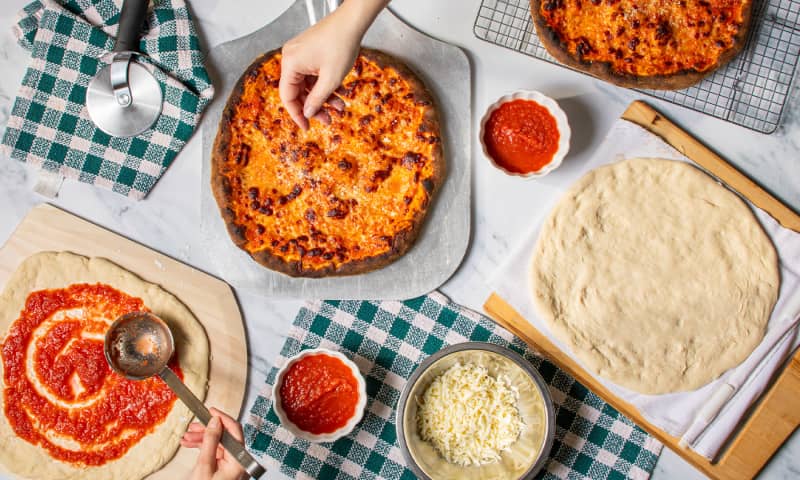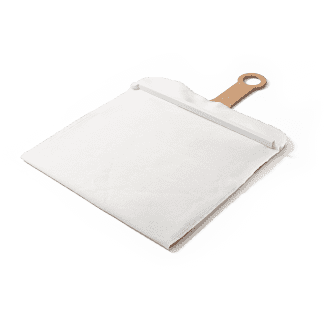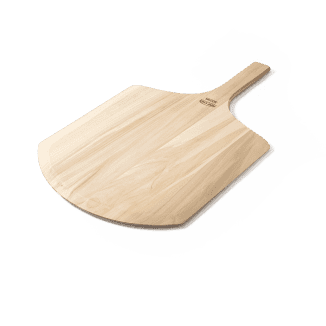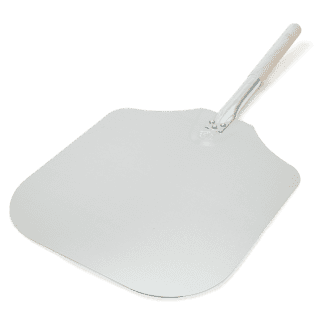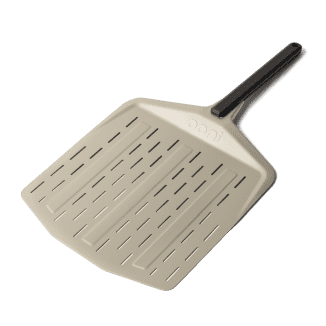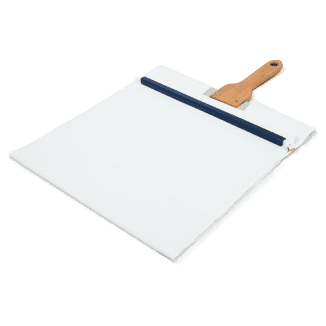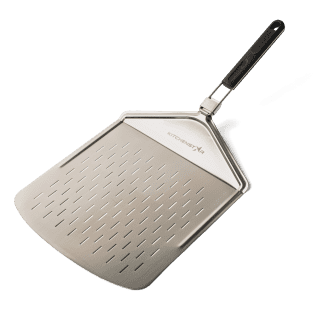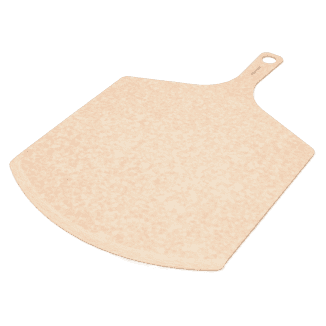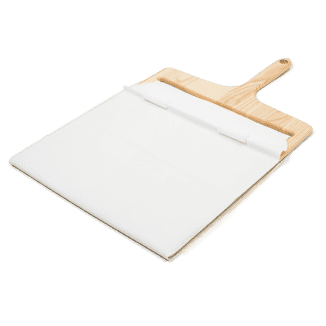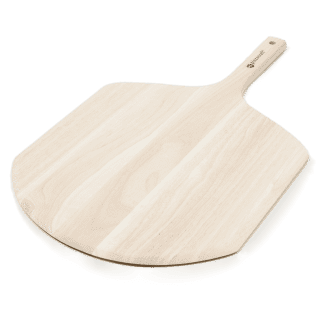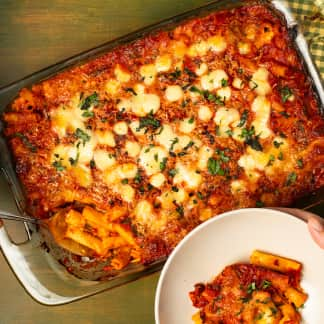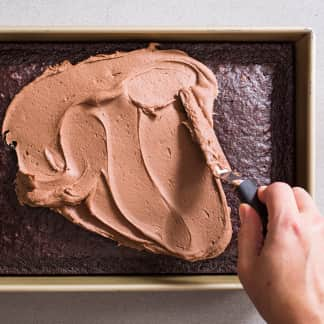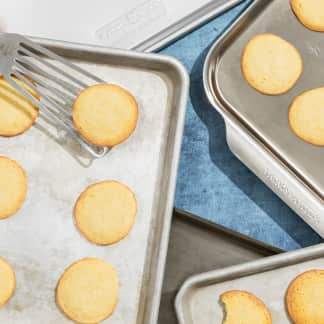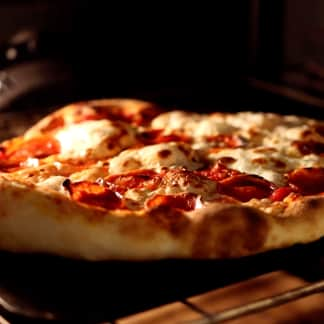We often use baking peels to move pizza, bread, and other baked goods into, out of, and within hot ovens. We tested a variety of different peels to see which were best. In keeping with what we’d learned in our previous testing, we selected peels with blades (the flat, spatula-like part) at least 14 inches wide, allowing us to accommodate large loaves comfortably, and handles that were about 8 inches long, giving us just enough distance from the heat of the oven without sacrificing control.



Different types of peels have different advantages. Our top choice (left) is great at unloading raw dough (which is the hardest task) and good at removing the finished pizza or bread. Wood peels (center) are great for unloading dough, too, but less good at rotating and removing the finished product. And metal peels (right) are the best at rotating and removing bread and pizza but less good at unloading raw dough.
When baking, we use a peel for three specific tasks. First, we unload raw dough onto a hot baking stone in the oven. This is one of the riskier steps in the baking process, since delicate, carefully formed loaves and pizza rounds can lose their shape if they stick to the peel or get shaken off it too vigorously. Next, we rotate the bread or pizza in the oven to ensure even baking. And finally, we remove the baked items from the oven.

No peel excelled at all three tasks. The wood peel was very good at unloading the dough. Once it was lightly sprinkled with flour, even the stickiest dough slipped right off when we gave the peel’s handle a quick jerk, though occasionally perfect pizza rounds became a bit oblong when we were too forceful. Even better were the Super Peels, which were fitted with innovative cotton conveyor belts that were practically nonstick once dusted with flour, allowing us to unroll the thinnest and most fragile pizzas without misshaping them.
Unfortunately, none of these models were great at in-oven rotation. The wood peel was too thick to get up and under breads and pizzas easily—a design flaw that also made it hard to remove these foods when fully baked. And while you could technically pick up and rotate the half-baked breads and pizzas with the conveyer belts on the Super Peels, it took a little more time than we’d prefer. In addition, at 16 inches wide, the large aluminum Super Peel was a bit too big to maneuver comfortably within a standard home oven. That said, both did a reasonable—if slightly time-consuming—job of removing the finished goods.
By contrast, the metal and wood-fiber composite blades were much more agile when removing the bread and pizza, mostly because they were thinner (0.25 inches thick or less) and could slip under the food more easily. The problem was that raw dough tended to stick to these models; we had to coat them with lots of flour in order to unload the loaves and pizza rounds intact, leaving the food unpleasantly dusty when it came out of the oven.
Task performance aside, a few factors made certain peels easier to use than others. While the conventional metal, wood, and composite peels could be used right out of the box, the Super Peels were a bit trickier to set up and use. It was a little fussy to clip the conveyor belts together and get the tension just right, and it took a few attempts to figure out exactly where to position the peels when unloading. And because the conveyor belt must be deployed manually, you end up sliding your hand toward the very back of the hot oven, running the risk of roasting a knuckle or two in the process if you move slowly. With practice, however, this is less of an issue.

Some amateur pizzaiolos sing the praises of pizza peels with perforated blades for two reasons. One, their perforations mean that there is less surface area for the dough to stick to, theoretically making it easier to unload sticky doughs. And, two, the perforations also allow more flour to fall off the pizza dough before cooking, resulting in a less dusty finished pizza. While we liked one of the perforated models we tested, we didn’t find either to be less sticky than our favorite metal model.

Which peel should you buy? It depends. While it has a bit of a learning curve, we think that the EXO Non-Stick Super Peel Pro Composite is the best option overall. It excels at the riskiest task a peel performs—unloading delicate doughs without deforming them—and does a decent job of removing the finished baked goods, too. But it’s pricey, and some folks find it a bit finicky to use. If you’d like to save a little money, you might consider going with our favorite wood peel, the New Star Foodservice 50295 Restaurant-Grade Wooden Pizza Peel, 16" L x 14" W. It unloads raw dough almost as well as our winner does, and it’s a good choice if you don’t mind using tongs to rotate half-baked pizzas and coax finished goods back onto its blade. Alternatively, you could purchase our favorite metal peel, the American Metalcraft Pizza Peel 2814, which does a great job of rotating and removing baked goods. Because raw dough can stick to metal, you’ll need to dust the blade heavily with flour, or build your pizza or shape your bread on parchment paper to ensure that you’re able to unload it easily. One final tip? If you have the storage space, you might prefer to do as professional bakers do and buy two peels—a wood one for unloading dough and a metal one for rotating and removing. That way, you have the best tools for each task.
The Tests
- Unload, rotate, and remove Thin-Crust Pizza
- Unload, rotate, and remove Rustic Italian Bread
How We Rated
- Unloading: We evaluated the peels on how easily they unloaded raw dough onto the baking stone.
- Rotating: We evaluated the peels on how easily they rotated half-cooked pizzas and loaves within the oven.
- Removing: We evaluated the peels on how easily they removed the finished baked goods from the oven.
- Ease of Use: We evaluated the peels on how easy they were to set up and prepare and on how comfortable they were to hold and use.
